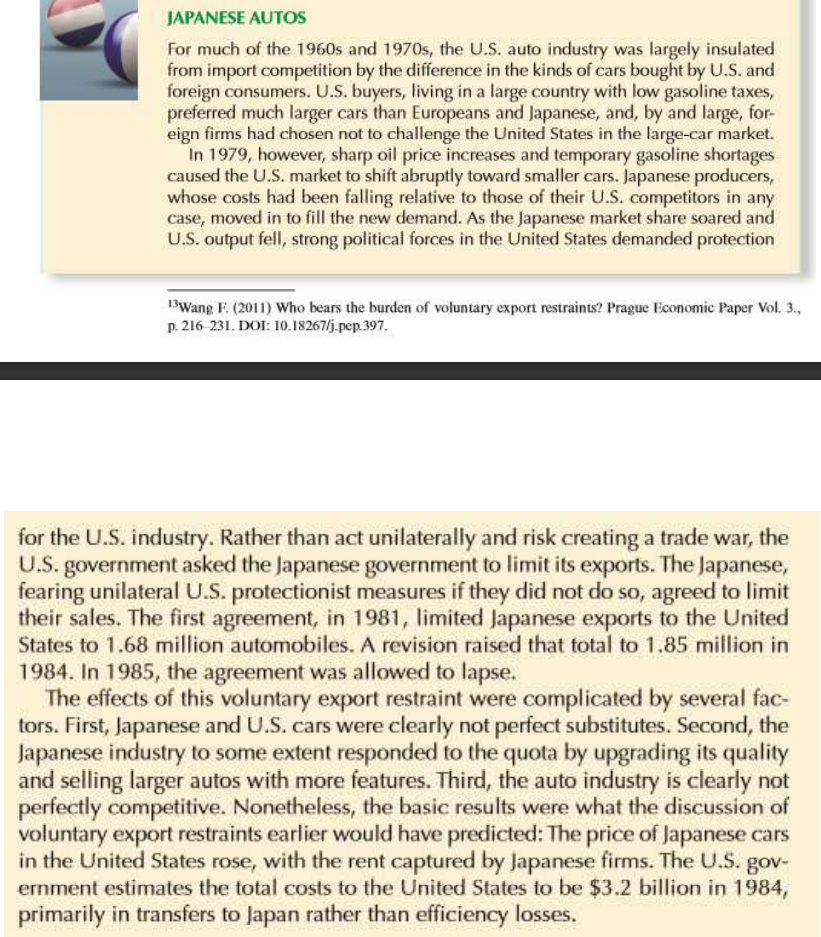Economics: Private and Public Choice (MindTap Course List)
16th Edition
ISBN:9781305506725
Author:James D. Gwartney, Richard L. Stroup, Russell S. Sobel, David A. Macpherson
Publisher:James D. Gwartney, Richard L. Stroup, Russell S. Sobel, David A. Macpherson
Chapter24: Price-searcher Markets With High Entry Barriers
Section: Chapter Questions
Problem 9CQ
Related questions
Question
**What are the Economic Effects on the Country that were involved in this Case**

Transcribed Image Text:JAPANESE AUTOS
For much of the 1960s and 1970s, the U.S. auto industry was largely insulated
from import competition by the difference in the kinds of cars bought by U.S. and
foreign consumers. U.S. buyers, living in a large country with low gasoline taxes,
preferred much larger cars than Europeans and Japanese, and, by and large, for-
eign firms had chosen not to challenge the United States in the large-car market.
In 1979, however, sharp oil price increases and temporary gasoline shortages
caused the U.S. market to shift abruptly toward smaller cars. Japanese producers,
whose costs had been falling relative to those of their U.S. competitors in any
case, moved in to fill the new demand. As the Japanese market share soared and
U.S. output fell, strong political forces in the United States demanded protection
13Wang F. (2011) Who bears the burden of voluntary export restrainis? Prague Economic Paper Vol. 3.,
p. 216 231. DOI: 10.18267/j.pep. 397.
for the U.S. industry. Rather than act unilaterally and risk creating a trade war, the
U.S. government asked the Japanese government to limit its exports. The Japanese,
fearing unilateral U.S. protectionist measures if they did not do so, agreed to limit
their sales. The first agreement, in 1981, limited Japanese exports to the United
States to 1.68 million automobiles. A revision raised that total to 1.85 million in
1984. In 1985, the agreement was allowed to lapse.
The effects of this voluntary export restraint were complicated by several fac-
tors. First, Japanese and U.S. cars were clearly not perfect substitutes. Second, the
Japanese industry to some extent responded to the quota by upgrading its quality
and selling larger autos with more features. Third, the auto industry is clearly not
perfectly competitive. Nonetheless, the basic results were what the discussion of
voluntary export restraints earlier would have predicted: The price of Japanese cars
in the United States rose, with the rent captured by Japanese firms. The U.S. gov-
ernment estimates the total costs to the United States to be $3.2 billion in 1984,
primarily in transfers to Japan rather than efficiency losses.
Expert Solution
This question has been solved!
Explore an expertly crafted, step-by-step solution for a thorough understanding of key concepts.
Step by step
Solved in 2 steps

Knowledge Booster
Learn more about
Need a deep-dive on the concept behind this application? Look no further. Learn more about this topic, economics and related others by exploring similar questions and additional content below.Recommended textbooks for you

Economics: Private and Public Choice (MindTap Cou…
Economics
ISBN:
9781305506725
Author:
James D. Gwartney, Richard L. Stroup, Russell S. Sobel, David A. Macpherson
Publisher:
Cengage Learning

Microeconomics: Private and Public Choice (MindTa…
Economics
ISBN:
9781305506893
Author:
James D. Gwartney, Richard L. Stroup, Russell S. Sobel, David A. Macpherson
Publisher:
Cengage Learning

Principles of Economics 2e
Economics
ISBN:
9781947172364
Author:
Steven A. Greenlaw; David Shapiro
Publisher:
OpenStax

Economics: Private and Public Choice (MindTap Cou…
Economics
ISBN:
9781305506725
Author:
James D. Gwartney, Richard L. Stroup, Russell S. Sobel, David A. Macpherson
Publisher:
Cengage Learning

Microeconomics: Private and Public Choice (MindTa…
Economics
ISBN:
9781305506893
Author:
James D. Gwartney, Richard L. Stroup, Russell S. Sobel, David A. Macpherson
Publisher:
Cengage Learning

Principles of Economics 2e
Economics
ISBN:
9781947172364
Author:
Steven A. Greenlaw; David Shapiro
Publisher:
OpenStax